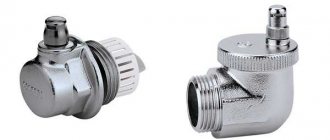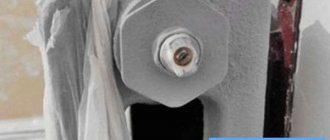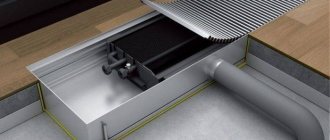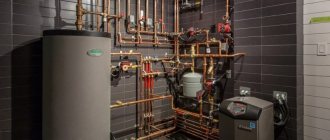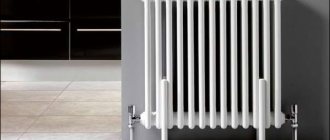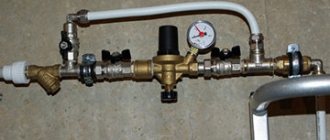Water heating lines have a characteristic feature. When pipelines are filled with water, part of the system remains occupied by air cushions. Normal operation of water heating in such cases is not ensured, so air from the pipelines must be removed manually.
The Mayevsky tap helps to get rid of air jams - the simplest mechanism for manually bleeding air. In the article we presented, the principle of operation of the device is analyzed in detail and alternative options are considered. The recommendations we provide will be useful in installation and operation.
How is the air exhaust mechanism installed?
The Mayevsky manual tap is a self-sealing device. The product kit includes an O-ring made of rubber, so there is no need to use any additional sealing materials.
Traditionally, the installation of manual valves for bleeding air of this type is performed in conjunction with radiator fittings (1 dm x ½ dm; 1 dm x ¾ dm). As an installation tool, use a spanner wrench specially designed for working with fittings and plugs.
Plumbing socket wrench for installing radiator casings and plugs. 1 – ring wrench, 2 – radiator cap, 3 – radiator cap. These tools and parts are often used when installing air vent valves
The operation of Mayevsky valves (air vents) is permissible only at the pressure and temperature values specified in the standards. These values are determined by the technical characteristics of the device.
Where can I buy?
Some domestic manufacturers and suppliers:
- OJSC Bologovsky Valve Plant offers inexpensive taps (about 35 rubles) Telephone 223-08-98, 660-27-53, Moscow.
- LLC Penzapromarmatura Tel., Penza.
- On the website of the Santekh-Detal company you can purchase taps from such foreign manufacturers as General Fittings, Itap (Italy), Microtecnica Trevisana at affordable prices. Tel.
- You can also purchase expensive Itap air vents from the Abion plumbing company (address in Moscow, Nagatinskaya St., 29, building 4).
Beware of low-quality fakes of dubious production. They may crack during installation.
Technical characteristics of the air vent
The required functional properties are presented in the following table:
| Technical specifications | Permissible value | Units |
| Pressure (working) | 10 | ATI |
| Temperature (maximum) | 120 | ºС |
| Passage diameter | 25.4 or 20.0 | mm |
| Thread diameter | 25.4 or 20.0 | mm |
| Working environment | water and other non-aggressive liquids | — |
| Life time | 20 — 25 | years |
| Leakage class | "A" | — |
During operation, malfunctions in the operation of the devices cannot be ruled out. A frequent reason for the loss of performance of Mayevsky cranes is small debris moved by the coolant.
If the faucet becomes clogged and no longer works, it is recommended to carry out simple maintenance:
- Isolate the radiator from the system with shut-off valves.
- Release approximately 1/3 of the water volume from the battery.
- Remove the device from the battery case.
- Clean the passage hole with a thin (non-metallic) sharp object.
Heating systems are not always equipped with radiators that have plugs with ready-made holes for Mayevsky taps. In such cases, the terminals for the air vents will have to be made by hand. No particular difficulties are foreseen in this matter. You just need to drill a hole for the installation size of the faucet and cut the thread.
The installation of taps in the housing of cast iron heating radiators should be given special attention. Products made from high-quality, reliable materials are traditionally used here.
The hole is drilled with a metal drill using a drill, and the thread is cut with a tap. Of course, the diameter of the drill is chosen 1 - 1.5 mm less than the installation size of the faucet, and the tap is exactly the size.
Installation
There is nothing difficult about installing a faucet. It is enough to select the battery on which it will be located and remove the side plug from it.
At the same time, it is important to make sure that there is no water in the system, because the Mayevsky tap is installed outside the heating season, or when the water supply is completely shut off for individual heating. Having unscrewed the plug, all that remains is to screw in the Mayevsky tap in its place. Thanks to the standard thread, it fits all modern batteries and Soviet-era radiators
Thanks to the standard thread, it fits all modern batteries and Soviet-era radiators
Having unscrewed the plug, all that remains is to screw in the Mayevsky tap in its place. Thanks to the standard thread, it fits all modern batteries and Soviet-era radiators.
How is it used
- Free up space near the radiator so that in an unforeseen situation you do not damage household appliances or furniture;
- Prepare a basin or bucket for water;
- Arm yourself with a screwdriver that fits the thread;
- Insert the tool into the thread with which the Mayevsky tap is equipped and slowly rotate it with a screwdriver. You need to move counterclockwise;
- Soon you will hear a hissing sound, which indicates air is escaping. At this point, stop turning the faucet;
- Even if the sound is loud, don't be alarmed. This principle of operation of the device is due to high pressure, which is why the sound is strong;
- Watch when water starts pouring out along with the escaping air. Do not rush to close the knot, the water should flow in a uniform stream;
- After this, carefully twist the element, moving in the opposite direction;
- Be sure to wait until all the air has escaped. In some cases the process takes a long time;
- The battery has warmed up to the required level, which means the job was done correctly.
But there are situations when, after bleeding the air, the radiator does not heat up. This is due to clogging. You should call a plumber to clean the system, or replace the battery completely.
Tips for use
Having installed the faucet, you need to use it wisely for your own benefit. A few simple rules will help you avoid common mistakes.
- The device must be installed directly on the heating radiator.
- To work with the Mayevsky faucet you will need one screwdriver. If it is installed in a hard-to-reach place, then arm yourself with an additional small special key.
- Do not install the device near water sources or smoking areas. In addition to air, accumulated explosive gases may escape from the system.
- Do not keep the tap open as the radiator will fail over time.
- If you haven't opened the tap for a long time, rust will form on the threads. To avoid torturing yourself and putting in a lot of effort, use kerosene. Lubricate the thread with it, wait a few minutes. Spin it.
The use of the Mayevsky crane in the conditions of current heating systems is extremely important. With its help, air jams are eliminated, the operation of radiators is normalized, their service life is extended, and savings are guaranteed during the heating season.
As you understand, installing it yourself will not be difficult if you follow the recommendations and adhere to safety rules. The device is inexpensive, but it becomes an integral part of your life.
Features of inclusion in the heating system
There are some peculiarities in the installation of air vent valves when they are screwed into the body of existing radiator plugs. Radiator plugs are usually screwed into the left-hand thread.
Image gallery
Photo from
Automatic air vent in the safety group
Using an air separator
Installation of air vents on each circuit
Air vent for underfloor heating system
The faucet twists to the right, and therefore the plumber needs to fix the plug with one key and at the same time tighten the air vent with the second. But these are technical details that it wouldn’t hurt for inexperienced people to know about.
The formation of air pockets is a problem inherent in systems with forced circulation. To bleed air, they are equipped with either an automatic air vent on the riser (right) or Mayevsky valves on each radiator (left)
The installation diagram for air exhaust devices also has some features. So, if the radiator system is built according to a vertical arrangement of devices, air vent valves are usually placed on the heating radiators of the highest level.
But in a parallel connection scheme, even with a vertical structure, Mayevsky taps are installed in heating devices of the lower and upper levels. In general, in plumbing practice, installation in each individual case is done taking into account the possible accumulation of air in the system.
Instead of Mayevsky taps on each radiator or an air vent on the riser, an air separator can be included in the system. Its action is based on Henry's law, according to which air is released from water and removed outside the closed loop
If the heating system is installed according to a horizontal scheme, then, as a rule, each heating device is equipped with air vents. By and large, it is advisable to equip almost any heating system equipment with air vent valves.
In reality the following equipment should be equipped:
- all heating batteries in the system;
- compensators, bypasses and similar devices;
- recorders and coils;
- pipelines of the upper level of the heating system.
Some circuit solutions even provide for the placement of a Mayevsky tap on heated towel rails. By the way, there are models of heated towel rails on sale whose designs have an entry point for the Mayevsky tap.
Reviews
- Many, having tried to bleed air using the Mayevsky tap, discovered that this was a rather lengthy process. However, this is to be expected.
- A number of buyers set out to find branded faucets from foreign manufacturers. As a result, they were disappointed that they could not be distinguished externally, nothing confirmed their “noble” origin, and it was impossible to check whether you were really overpaying for nothing.
- Those who installed automatic taps were faced with another feature - the inability to drain water when the need arose. Installed together, the air vent and drain valve looked cumbersome.
- Another unpleasant moment from user experience is that the faucet jammed so much that both it and the radiator plug had to be replaced. The reason is the long inactivity of the mechanism.
Advice for business
Before deciding to purchase air exhaust devices, it is recommended to carefully study the arrangement of devices in the heating circuit.
Small-sized special keys are convenient to use in cramped conditions, where the use of a screwdriver is hampered by nearby other objects
Depending on the degree of freedom of access to the equipment, Mayevsky cranes of a suitable modification should be installed.
Where it is difficult to work with a screwdriver, turnkey models are better suited, and where it is difficult to work with keys, it is wise to place automatic devices. Careful analysis will help make device maintenance more efficient and save on purchases.
Automatic air vents are traditionally installed on pipeline lines, at points of potential accumulation of air masses. Such devices, as a rule, are not used on radiators.
Manual devices have the most simplified design, for example, compared to automatic air vents. But, as practice shows, simplicity is the key to reliability.
If cast iron radiators are used in the heating system, manual taps are more reliable for such a system than automatic ones. Meanwhile, the degree of reliability of the design largely depends on the quality of the metal (brass) from which the air vent is made.
Mayevsky tap assembled with a nylon plug. Design specially prepared for installation in a system built on polypropylene pipes
You can also mention the experience of introducing Mayevsky taps into heating circuits built on plastic pipes. This material quite reliably maintains stable pressure and temperature, but is weak against water hammer.
Installing a Mayevsky crane paired with a safety valve or a full-fledged safety group increases the reliability of the system for such cases. In general, for circuits where pressure stability is in question, it is recommended to use taps as stabilizers.
Mayevsky automatic crane
The manual valve is quite easy to use; even those who have never previously been interested in repairing heating systems do not face any difficulties. However, in places with stable aeration of the system, it is logical to install a faucet with an automated air exhaust function. The cause of the problem of excessive air release may be improper installation of heating pipes. An automatic air vent allows you to avoid removing air manually all the time. This model is especially convenient for installation in labor-intensive places.
Mayevsky automatic crane
The design features of automatic air vents may be different, but the operation remains the same. There is an empty space in the housing with a plastic float. Using a flag, he presses on the rod with a spring, then access to the atmosphere is opened and the air is removed. When the cavity is filled with liquid, the float presses on the rod, thereby closing the hole and preventing liquid from leaking out.
To make it easier to carry out repair work in the event of a breakdown or replacement of an old tap, a shut-off valve is attached to the device. It should be screwed into the heating system, then screw on the air vent. The tap presses on the flag on the valve and thereby prevents liquid leakage.
Such automated devices can be found in professional stores in large quantities. You can see radiator, corner, special, and straight air vents. Therefore, you can choose this device for any heating system.
Conclusions and useful video on the topic
The video demonstrates the principle of operation of the Mayevsky crane and provides recommendations for its installation:
Simple in design and easy to maintain, air vents are also an integral technical part of any heating system. Deliberate exclusion of devices from the system threatens to result in serious consequences, including defrosting of batteries and pipes in winter. It is impossible to ignore Mayevsky’s taps; they just need to be selected for a specific system.
Please write comments in the block below. Tell us about your own experience in installing mechanical air vents. Ask questions, share your opinion and photographs on the topic.
Principle of operation
Let's look at how the Mayevsky crane works. The Mayevsky valve is the common name for a needle air valve developed in the 30s of the last century.
A small mechanism is installed at the highest point of the radiator where air accumulates.
In essence, this is a small hole through which the “plug” is manually released. The hole is closed with a special screw.
How to determine when to bleed air from radiators:
- At the beginning of the heating season (in summer the water is often drained).
- After repair work or replacement of coolant in private homes.
- If you notice that the system is heating up and the batteries are not warm enough.

